GUIDED READING
Lesson Plans, Tips, and Strategies for Guided Reading
Keep checking this page for more free resources and activities to help you with your guided reading instruction! Research is clear about the need for early, effective reading instruction. Low-performing first grade readers will likely be the lowest performing readers in the fourth grade.
As many schools are adapting to an ever-increasing range of learners, it becomes important to develop instruction to respond to these diverse students.
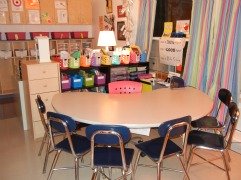 Guided Reading is a teaching approach that is designed to help individual students learn how to process a variety of increasingly challenging texts with understanding and fluency. This type of teaching and learning is most effective when instruction is delivered in the smallest group possible to address the specific literacy needs of the students. The teacher selects and introduces texts to readers, supports them while reading the text, engages the readers in discussion, and performs mini-lessons before, during, and after the reading. The teacher can also extend the meaning of the text through writing or another learning activity.
Guided Reading is a teaching approach that is designed to help individual students learn how to process a variety of increasingly challenging texts with understanding and fluency. This type of teaching and learning is most effective when instruction is delivered in the smallest group possible to address the specific literacy needs of the students. The teacher selects and introduces texts to readers, supports them while reading the text, engages the readers in discussion, and performs mini-lessons before, during, and after the reading. The teacher can also extend the meaning of the text through writing or another learning activity.
Tyner (2005) highlights key points that make guided reading successful:
- Small-group instruction provides comprehensive coverage of the strategies required to move students to greater achievement in reading.
- Every group of students is given quality reading instruction and tasks that are worthwhile.
- Assessment is ongoing and directly linked to instruction. Teachers gather information from both formal and informal assessments about how their students are progressing in their learning at a given point.
- Students are constantly evaluated and shuffled and reshuffled in flexible groups to best meet instructional needs.
- Differentiated reading takes into consideration the individual characteristics of the children, capitalizes on the strengths they have, and expands and challenges their abilities.
Although this page focuses on small-group reading instruction, the additional components of a balanced literacy program cannot be over-looked.
ORGANIZING YOUR GUIDED READING TABLE
Thoughts On Setting Up Your Reading Table:
- Have a clear view of all literacy stations so that you can see what the rest of the children are doing.
- Place your table in location that allows you to hang anchor charts.
- Use shelves and baskets to hold your small-group materials.
- Label containers holding materials for easy storage and access.
- "Block in" your reading table in by pieces of furniture that not only serve as instructional pieces, but can give students privacy from students in literacy centers. (As shown below).
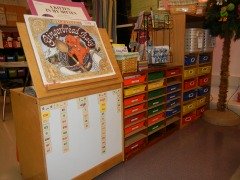
|
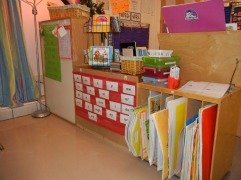
|
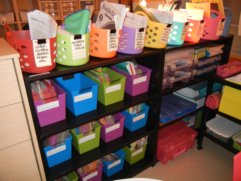
|
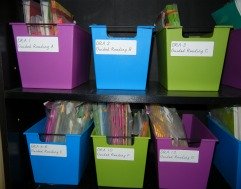
|
A well-organized small-group area that has all materials where they're needed allows for effective instruction. Multiple copies of leveled books are used daily for reading instruction and can be pulled quickly when they are grouped according to these levels. By placing labels on your bins, you can readily access books and not wasted time figuring out how differing levels correlate. Use with Avery 8163 labels.
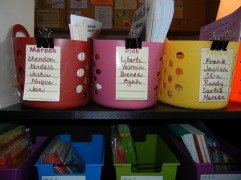
|
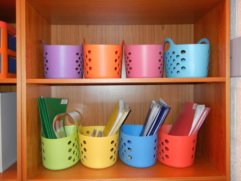
|
In order to keep materials organized, try naming your reading groups with a color. Everything you need for that group will be kept in that colored bin. Print off the above template on card stock, laminate, and write names using a Vis-a-Vis (when your groups change, you can easily erase the names and use again).
The picture on the left shows the materials the teacher will be using with each guided reading group. In another location of the classroom where children can easily access the bins, the same colored bins are used for placing books, games, magnetic letters, etc. taught in the small-group setting that those students can later use during literacy centers. (Shown in the picture on the right).
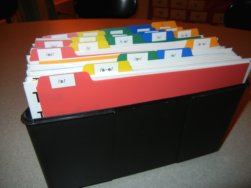
|
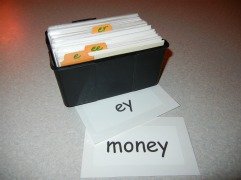
|
To organize the materials that can be purchased on Download Central Page, try using plastic index card boxes with dividers. These items are used daily and by taking the time to organize them, less wasted time is spent when the children are at the reading table! These containers and dividers can be purchased at your local office supply store and come in many different colors and sizes!
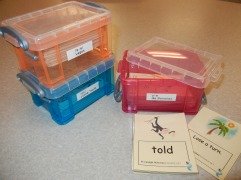
Reading Games
To organize the reading games that can be purchased on Download Central Page, use clear, plastic containers that are stackable and can be placed in the colored bins (as mentioned above) for students to use during small-group instruction and during literacy centers.
GUIDED READING LESSON PLANS
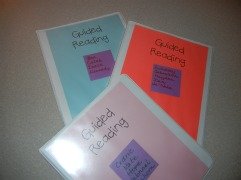
Binder Insert
Create an organized way to keep your lesson plans for each reading group by placing a colored piece of paper (that corresponds with the color of your reading group as suggested above) in a small binder. Write the names of your students on a Post-It Note and place it in the center. Change the Post-Its as your reading groups change!
Blank Running Record Template and Running Record Scoring
A running record is a reading assessment that can be done quickly and frequently. It is an individual formative assessment. It provides a representation of a student's oral reading, identifying patterns of effective and ineffective strategy use.
GUIDED READING PRINTABLE & IDEAS
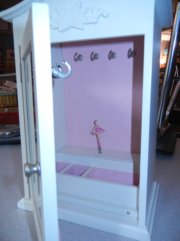
Super Centers
By keeping a music box at your guided reading table, you can manage the children who are working at literacy centers when you are working with a small group without having to interrupt the reading going on. If it gets too loud, turn the music box on until it's quiet again. If the music box was not used during the day, one letter of "Super Centers" gets colored in. When all of the letters have been colored, the children will receive a reward (extra recess, movie, new classroom book, etc.) If there is music in the box at the end of the week, the children will receive a special "treat" inside the music box. If all the music in the box is gone before the end of the week, the class will use up music for the following week.
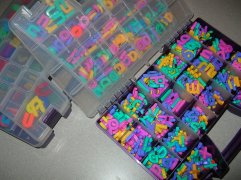
Magnetic Letters
Having a set of magnetic letters readily available (uppercase and lowercase) is a must! Early learners need opportunities to manipulate letters. Craft stores have many organizational containers for storing letters of the alphabet that are easy for young children to use!
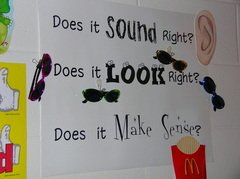
Reading Self-Check Poster
By enlarging this template you can help students learn and remember important self-check strategies when reading. We have found that it is beneficial to add objects to each strategy!
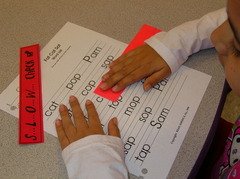
Slow Check Template
Some children have difficulty tracking print when they are beginning to look at words. Cover up the word with the "Slow Check" and move slowly to the right, while saying each sound. Blend the sounds to read the word.










